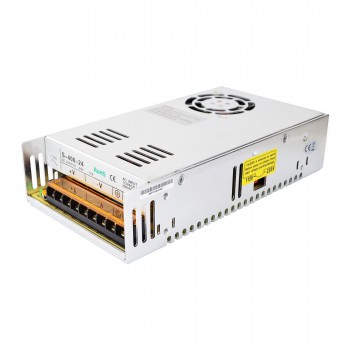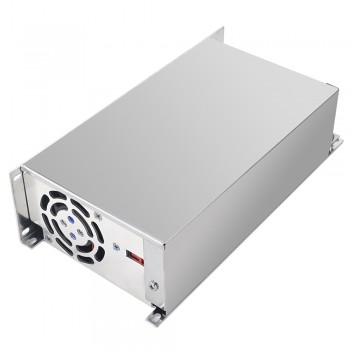1.What is switching power supply?
A switching power supply is an electronic power converter that efficiently changes voltage levels by rapidly switching a transistor on and off. It converts AC or DC input power into a regulated DC output, is much smaller and more efficient than a traditional linear power supply, and is used in everything from laptops to smartphones. The high-frequency switching allows for the use of a smaller transformer and filter, but can also create noise that requires filtering.

2.Working principle of switching power supply.
1.Input Rectification: The input AC power is first converted to a rough DC voltage using a rectifier circuit.
2.High-Frequency Switching: This DC voltage is then fed into a high-speed power transistor (like a MOSFET) that acts as a switch. It rapidly turns the voltage on and off, creating a high-frequency pulse train.
3.Voltage Transformation: The high-frequency pulses are sent through a small transformer to step the voltage up or down to the desired level. Using a high frequency allows for a smaller, more efficient transformer.
4.Output Rectification and Filtering: The high-frequency AC output from the transformer is again rectified into DC and then passed through filters to smooth out the remaining ripples, producing a stable DC output voltage.
5.Feedback Control: A control circuit constantly monitors the output voltage. If it deviates from the target, it adjusts the switching speed (the duty cycle) of the transistor to correct it, ensuring a stable output.
3.Main design advantages of switching power supply
1.High efficiency: Switching power supplies are significantly more efficient, with efficiencies up to 98–99%. This is because the switching transistors are either fully on or fully off, dissipating very little power. This efficiency leads to lower energy consumption and reduced operational costs.
2.Compact and lightweight: The high-frequency operation enables the use of smaller, lighter transformers and other components, resulting in a smaller overall size and weight. This makes them ideal for compact devices and allows for greater design flexibility.
3.Lower heat generation: Due to their high efficiency, less energy is lost as heat. This reduces the need for bulky cooling systems and improves reliability, as components operate at lower temperatures.
4.Wide input voltage range: They can be designed to operate over a wide range of input voltages, making them versatile for global use without needing different power adapters.
5.Versatility and power output: Switching power supplies can be designed as “boost” converters to produce an output voltage higher than the input voltage, a capability not possible with linear supplies. They can also provide high power output for larger applications.
6.Cost-effectiveness: Despite their complexity, the high efficiency and smaller size can make them more cost-effective, particularly for high-power applications.
7.Enhanced protection: They often include advanced protection features, such as overvoltage, overcurrent, and short-circuit protection, to safeguard the equipment and user.

4.Common problems of switching power supply
1.No Output, Good Fuse:One of the first things you should check when troubleshooting power supply issues is the fuse. If the fuse is intact but there is no output, the problem lies elsewhere. Common causes could include a malfunction in the control circuit or issues in the power regulation components, such as the rectifier diodes or smoothing capacitors.
2.Blown Fuse:A blown fuse is a clear indicator that something has gone wrong inside your switching power supply. The fuse is designed to protect the components from overload or short circuit. In general, a blown fuse suggests a problem with internal circuits. Voltage surges or fluctuations can cause a sudden current increase, leading to a blown fuse. To address this issue, you should inspect the rectifier diodes, high-voltage capacitors, and the power switch tube to look for signs of breakdown or damage.
3.No DC Output or Unstable Voltage Output:If the fuse is intact but you’re not getting the correct DC output or the voltage is unstable, several components may be at fault. The issue could stem from an open circuit, short circuit, overload, or failure in the auxiliary power supply. Additionally, breakdowns in high-frequency rectifiers or electric leakage in smoothing capacitors can cause these issues.
4.Poor Load Capacity:A power supply’s load capacity can degrade over time, especially in traditional units or those that have been in use for long hours. Aging components, unstable switching tubes, or inadequate cooling can result in poor load handling. In such cases, inspect the regulated diodes, rectifier diodes, and high-voltage smoothing capacitors to determine if any components are malfunctioning.
5.SMPS Partially Working:If your switching power supply seems to work intermittently or partially, the issue could be related to the high-frequency rectifier circuit, the control circuit, or protective features within the power supply. For instance, some power supplies may exhibit partial functionality when certain components, like the rectifier diodes or capacitors, fail but the rest of the circuitry is intact.
6.Audible Noise:Humming or buzzing noises emanating from your switching power supply are often a sign of underlying issues. Audible noise typically comes from components like transformers, capacitors, or fans. In some cases, this can indicate faulty capacitors, aging components, or mechanical interference.